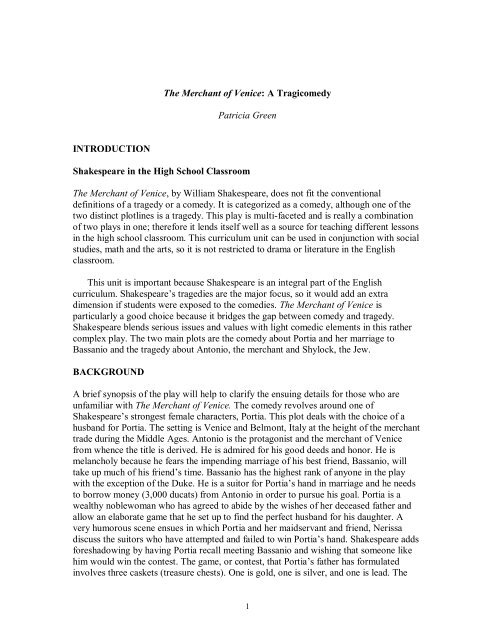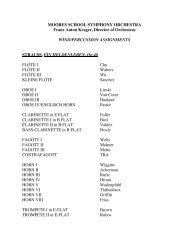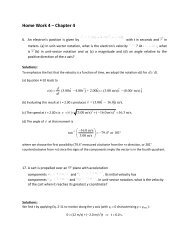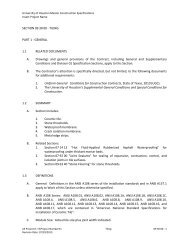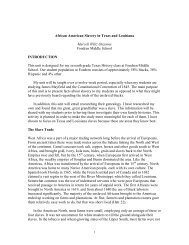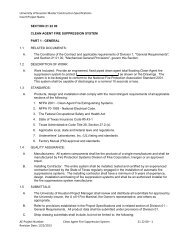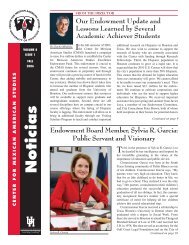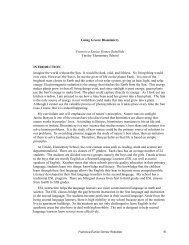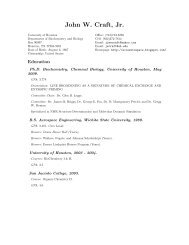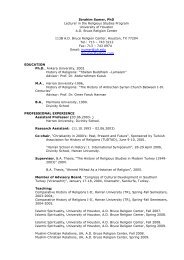The Merchant of Venice: a Tragicomedy - University of Houston
The Merchant of Venice: a Tragicomedy - University of Houston
The Merchant of Venice: a Tragicomedy - University of Houston
Create successful ePaper yourself
Turn your PDF publications into a flip-book with our unique Google optimized e-Paper software.
INTRODUCTION<br />
<strong>The</strong> <strong>Merchant</strong> <strong>of</strong> <strong>Venice</strong>: A <strong>Tragicomedy</strong><br />
Patricia Green<br />
Shakespeare in the High School Classroom<br />
<strong>The</strong> <strong>Merchant</strong> <strong>of</strong> <strong>Venice</strong>, by William Shakespeare, does not fit the conventional<br />
definitions <strong>of</strong> a tragedy or a comedy. It is categorized as a comedy, although one <strong>of</strong> the<br />
two distinct plotlines is a tragedy. This play is multi-faceted and is really a combination<br />
<strong>of</strong> two plays in one; therefore it lends itself well as a source for teaching different lessons<br />
in the high school classroom. This curriculum unit can be used in conjunction with social<br />
studies, math and the arts, so it is not restricted to drama or literature in the English<br />
classroom.<br />
This unit is important because Shakespeare is an integral part <strong>of</strong> the English<br />
curriculum. Shakespeare‟s tragedies are the major focus, so it would add an extra<br />
dimension if students were exposed to the comedies. <strong>The</strong> <strong>Merchant</strong> <strong>of</strong> <strong>Venice</strong> is<br />
particularly a good choice because it bridges the gap between comedy and tragedy.<br />
Shakespeare blends serious issues and values with light comedic elements in this rather<br />
complex play. <strong>The</strong> two main plots are the comedy about Portia and her marriage to<br />
Bassanio and the tragedy about Antonio, the merchant and Shylock, the Jew.<br />
BACKGROUND<br />
A brief synopsis <strong>of</strong> the play will help to clarify the ensuing details for those who are<br />
unfamiliar with <strong>The</strong> <strong>Merchant</strong> <strong>of</strong> <strong>Venice</strong>. <strong>The</strong> comedy revolves around one <strong>of</strong><br />
Shakespeare‟s strongest female characters, Portia. This plot deals with the choice <strong>of</strong> a<br />
husband for Portia. <strong>The</strong> setting is <strong>Venice</strong> and Belmont, Italy at the height <strong>of</strong> the merchant<br />
trade during the Middle Ages. Antonio is the protagonist and the merchant <strong>of</strong> <strong>Venice</strong><br />
from whence the title is derived. He is admired for his good deeds and honor. He is<br />
melancholy because he fears the impending marriage <strong>of</strong> his best friend, Bassanio, will<br />
take up much <strong>of</strong> his friend‟s time. Bassanio has the highest rank <strong>of</strong> anyone in the play<br />
with the exception <strong>of</strong> the Duke. He is a suitor for Portia‟s hand in marriage and he needs<br />
to borrow money (3,000 ducats) from Antonio in order to pursue his goal. Portia is a<br />
wealthy noblewoman who has agreed to abide by the wishes <strong>of</strong> her deceased father and<br />
allow an elaborate game that he set up to find the perfect husband for his daughter. A<br />
very humorous scene ensues in which Portia and her maidservant and friend, Nerissa<br />
discuss the suitors who have attempted and failed to win Portia‟s hand. Shakespeare adds<br />
foreshadowing by having Portia recall meeting Bassanio and wishing that someone like<br />
him would win the contest. <strong>The</strong> game, or contest, that Portia‟s father has formulated<br />
involves three caskets (treasure chests). One is gold, one is silver, and one is lead. <strong>The</strong><br />
1
suitor who gets to choose does not know the choice <strong>of</strong> previous contestants. Each casket<br />
comes with a riddle that must be solved before it can be opened. Inside, if the counterfeit<br />
(picture) <strong>of</strong> Portia is enclosed, then that man will become her husband. <strong>The</strong> first man to<br />
try in Act 2 is Morocco who chooses gold and loses. <strong>The</strong>n Aragon, the Spaniard, tries<br />
after pr<strong>of</strong>essing that if he loses then he will never marry. He chooses the silver and loses.<br />
To Portia‟s surprise and delight, Bassanio is next. He chooses the lead casket and wins<br />
Portia‟s hand in marriage. Since this is a comedy, the main characters live happily ever<br />
after. Bassanio‟s manservant, Gratiano becomes enamored with Nerissa and the feelings<br />
are mutual, so both couples marry. Bassanio was able to woo Portia because Antonio<br />
gave him the loan <strong>of</strong> 3,000 ducats. Antonio‟s ships are at sea and his fortune is tied up<br />
with them, so he goes to a usurer. During the Medieval times it was considered a sin for a<br />
Christian to lend money for interest, so the job was <strong>of</strong>ten performed by a non-Christian.<br />
Shylock the Jew is probably one <strong>of</strong> Shakespeare‟s most famous characters. If Antonio<br />
does not pay his loan on time then Shylock will take his collateral <strong>of</strong> a pound <strong>of</strong> flesh.<br />
Antonio is generous because his friend needs the money and he is confident that his ships<br />
will come in. Shylock is betrayed by his daughter, who steals all <strong>of</strong> his riches and runs <strong>of</strong>f<br />
to marry a Christian and convert. This increases Shylock‟s need for vengeance. Antonio<br />
is unable to repay his loan because his ships are believed to be lost at sea. Antonio needs<br />
support <strong>of</strong> his friends, so Bassanio and Gratiano leave their brides in Belmont to travel to<br />
<strong>Venice</strong> for the trial. <strong>The</strong> wives graciously agree to part with their husbands under the<br />
condition that they never remove their wedding rings. After their husbands leave, Portia<br />
and Nerissa travel to <strong>Venice</strong> to help Bassanio‟s friend, Antonio. <strong>The</strong>y disguise<br />
themselves as the Duke (judge) and a law clerk. This is a very interesting scene because<br />
Shakespeare creates Portia and Nerissa as very strong female characters. A suspension <strong>of</strong><br />
belief is required here, since Bassanio and Gratiano don‟t recognize their wives. Shylock<br />
follows the letter <strong>of</strong> the law and wants his pound <strong>of</strong> flesh. He is <strong>of</strong>fered twice the amount<br />
<strong>of</strong> the loan and still demands his due. Portia turns the letter <strong>of</strong> the law against Shylock by<br />
demanding that he take his pound <strong>of</strong> flesh, but he is forbidden to shed one drop <strong>of</strong> blood.<br />
Shylock then becomes the accused and as punishment, he must leave all <strong>of</strong> his worldly<br />
goods to his daughter and convert to Christianity, which also ends his career as a usurer.<br />
Antonio‟s ships are found to be safe as well. <strong>The</strong> Shylock plot ends in Act 4, but there is<br />
still the plot involving Portia and Bassanio. <strong>The</strong> two husbands are so grateful to the Duke<br />
and the law clerk for saving their friend, Antonio that they <strong>of</strong>fer payment. <strong>The</strong> Duke<br />
(Portia) and the law clerk (Nerissa) insist that the only payment that they require is their<br />
wedding rings, thus the promise is broken. Portia and Nerissa make it back to Belmont<br />
before their husbands and chastise them dearly for giving away their rings, perhaps to<br />
other women. After a humorous scene <strong>of</strong> explanations and confusion, the women confess<br />
to their part in the court and, as in other Shakespeare comedies, everyone but the villain<br />
(Shylock) lives happily ever after.<br />
<strong>The</strong> Three Caskets: <strong>The</strong> Arranged Marriage<br />
For centuries marriages have been arranged. It may be enlightening to some students to<br />
find out that some cultures still practice this today. As an introduction to the play or to the<br />
2
events in Act 2, the teacher can give examples <strong>of</strong> matchmaking as practiced in different<br />
cultures around the world. Playing the song or showing the video <strong>of</strong> the song,<br />
“Matchmaker” from the play, Fiddler on the Ro<strong>of</strong> is one example. Leading up to the<br />
song, Tevye‟s daughters are poking fun at the possible male suitors for the eldest<br />
daughter‟s hand in marriage, just as Portia and Nerissa laugh about the suitors who have<br />
thus far failed to choose the correct casket, much to Portia‟s relief. <strong>The</strong> Walt Disney<br />
movie, Mulan, has a fun scene concerning matchmaking. Students with cable may be<br />
aware <strong>of</strong> the 1960s game show called <strong>The</strong> Dating Game and several “reality” programs<br />
have been broadcast recently that relate to choosing a compatible mate. On a serious note,<br />
respecting the good judgment <strong>of</strong> the parents is an important discussion or writing topic.<br />
Anti-Semitism<br />
In the Middle Ages, Christians were forbidden to lend money for interest (but not to<br />
borrow), so the pr<strong>of</strong>ession <strong>of</strong> usury was conducted by non-Christians. In <strong>The</strong> <strong>Merchant</strong> <strong>of</strong><br />
<strong>Venice</strong>, the usurer is Shylock the Jew. Shylock is not so much a villain as he is an antihero.<br />
He is a fascinating character study because Shakespeare most certainly had never<br />
met a Jew since Jews had been banished from England for three and a half centuries<br />
(1290-1655). This would be a good topic for students to research. <strong>The</strong> anti-Semitic theme<br />
can be approached in the classroom and this can <strong>of</strong>fer a cross-curricular opportunity with<br />
the social studies department.<br />
In order for the students to understand usury and its connection to anti-Semitism, a<br />
short explanation is in order. <strong>The</strong> source from the Anne Frank Foundation gives a quick<br />
easy-to-understand synopsis <strong>of</strong> the economic sources <strong>of</strong> anti-Semitism.<br />
In the last half <strong>of</strong> the Middle Ages, an increasing number <strong>of</strong> occupational groups<br />
formed guilds. Membership in a guild was limited to Christians, and only<br />
members <strong>of</strong> guilds were allowed to practice a craft. Jews were thus excluded from<br />
more and more occupations. <strong>The</strong> one alternative to trading in secondhand goods<br />
permitted was lending money at a rate <strong>of</strong> interest. For Christians this was<br />
explicitly forbidden by the Church as a sin. <strong>The</strong> unstable political and economic<br />
situation made interest rates high. This situation, the result <strong>of</strong> anti-Jewish<br />
measures, became the source <strong>of</strong> a new and tenacious anti-Semitic stereotype: the<br />
Jew as a greedy moneylender. Jews could buy protection from secular lords-for a<br />
great deal <strong>of</strong> money! -but they were never certain <strong>of</strong> their position. It was<br />
common for powerful persons who were in debt to Jews to banish them from the<br />
city or the country. Various anti-Jewish attitudes <strong>of</strong> economic or religious origin<br />
became deeply anchored in the thinking <strong>of</strong> the Christian world towards the end <strong>of</strong><br />
the Middle Ages, and the result was a fundamentally anti-Jewish attitude.<br />
(Boonstra, 36)<br />
Shylock <strong>of</strong>fers the opportunity to explore the roots <strong>of</strong> anti-Semitism in Medieval Europe<br />
as well as Renaissance England. One <strong>of</strong> Shakespeare‟s most famous speeches comes<br />
3
from Shylock in Act 3, scene 1:<br />
Hath not a Jew Eyes? Hath not a Jew organs, dimensions,<br />
senses, affections, passions? -fed with the same food, hurt<br />
with the same weapons, subject to the same diseases, healed<br />
by the same means, warmed and cooled by the same winter<br />
and summer as a Christian is? If you prick us, do we not<br />
bleed? If you tickle us, do we not laugh? If you poison us,<br />
do we not die? And if you wrong us, shall we not revenge?<br />
If we are like you in the rest, we will resemble you in that.<br />
If a Jew wrong a Christian, what is his humility? Revenge!<br />
If a Christian wrong a Jew, what should his sufferance be by<br />
Christian example? Why revenge! <strong>The</strong> villainy you teach me<br />
I will execute, and it shall go hard but I will better the instruction. (Shakespeare,<br />
87)<br />
This monologue lends itself well to a lesson on the delivery <strong>of</strong> a speech in a play.<br />
Thoughts can be presented vindictively or sympathetically, depending upon the actor‟s<br />
interpretation. This can be a lesson in comparison if two students are chosen to recite the<br />
two different interpretations in front <strong>of</strong> the class.<br />
When Charles Macklin revived <strong>The</strong> <strong>Merchant</strong> <strong>of</strong> <strong>Venice</strong> in<br />
1741 (it had not been performed since Shakespeare‟s time),<br />
he played Shylock as a monster, reviving old biases. Shylock<br />
was not portrayed sympathetically till Henry Irving‟s 1879<br />
performance. (Felsenstein)<br />
Shylock, the man, appears to be his own worst enemy because he is so consumed with<br />
greed and hate. A discussion on destructive emotions could be approached here. Also, an<br />
additional lesson about rhetorical questions can enhance the understanding <strong>of</strong> this speech.<br />
In order to gain a larger understanding <strong>of</strong> the character, the relationship between Shylock<br />
and his daughter, Jessica, can be scrutinized. This is yet another interesting facet <strong>of</strong> this<br />
complex play.<br />
<strong>The</strong> father-daughter relationship is another important component and motivation for<br />
Shylock‟s revenge. <strong>The</strong> students need to understand why it is a crisis for Shylock that his<br />
daughter converted and married a Christian man. It gives some insight into the<br />
importance <strong>of</strong> his religion. He is ridiculed for mourning over the loss <strong>of</strong> his ducats and<br />
his daughter in the same lamentation, indicating to the other characters and the audience<br />
that his lost wealth is as important to him as his daughter. This reinforces the villainous<br />
clown and the stereotype <strong>of</strong> the greedy Jew whose only interest is money. To emphasize<br />
the human side <strong>of</strong> Shylock, it is a good idea to spend some time discussing his<br />
lamentation over the loss <strong>of</strong> his late wife‟s ring that his daughter so callously traded for a<br />
monkey. Shylock has a heart after all. His vengeance toward Antonio may be enhanced<br />
4
due to this later disappointment, even though Antonio had treated Shylock with cruelty<br />
before the action <strong>of</strong> the play. It is made known to the audience in the dialogue between<br />
Antonio and Shylock. Antonio is portrayed heroically and the renaissance audience<br />
would see nothing wrong in Antonio‟s action <strong>of</strong> spitting at Shylock because it was<br />
acceptable practice in Medieval Europe to be able to show outward signs <strong>of</strong> disgust.<br />
“Fair sir, you spet on me Wednesday last,<br />
You spurn‟d me such a day, another time<br />
You called me dog; and for these courtesies<br />
I‟ll lend you thus much moneys?” (1.3)<br />
It may seem shocking to students today that people were treated so harshly. Another<br />
scene which displays, not just cruelty, but an intention to „help‟ the misguided Shylock is<br />
the courtroom scene in Act 4. Portia, disguised as the Duke (judge) orders Shylock to<br />
convert to Christianity. According to the belief <strong>of</strong> the European people in Medieval times<br />
and the Renaissance audience, Portia did Shylock a favor by “saving his soul.” <strong>The</strong> latter<br />
information can be glossed over if the teacher deems it <strong>of</strong>fensive to his or her students. In<br />
this era <strong>of</strong> political correctness, it is the emphasis in school and in society to treat all<br />
people with respect, to understand and to appreciate the differences and unique qualities<br />
in a culturally diverse world. Two discussion topics can spawn from this: the importance<br />
<strong>of</strong> treating each other with respect and the fact that in all probability, Shakespeare‟s<br />
audience had never seen a Jew. If there is time, or it can be <strong>of</strong>fered as an extra-credit<br />
assignment, students can research why the Jews were driven out <strong>of</strong> England and when<br />
they were allowed to return. (<strong>The</strong> Jews were expelled from England in 1290 and were not<br />
allowed to return until the seventeenth century). For a larger connection, students can<br />
come up with other incidents in history that demonstrate prejudice or it can be connected<br />
to a unit on the Holocaust, since that happened almost four centuries after Shakespeare<br />
wrote this play.<br />
Censorship<br />
Censorship in literature is a good enrichment lesson regarding Shakespeare, especially<br />
since <strong>The</strong> <strong>Merchant</strong> <strong>of</strong> <strong>Venice</strong> involves anti-Semitism. This is by no means the only<br />
controversial Shakespearean play taught in the high school classroom.<br />
<strong>The</strong>re are some English textbooks that censor a line in Macbeth because it may be<br />
<strong>of</strong>fensive. In the witches‟ incantation in Act 4, scene 1, two lines are omitted: “Liver <strong>of</strong><br />
blaspheming Jew, Gall <strong>of</strong> goat, and slips <strong>of</strong> yew” (Riverside Shakespeare, 1376). A<br />
lesson on censorship and the reasons why certain materials are censored would be a<br />
valuable lesson in today‟s high school classroom. This can be an extension <strong>of</strong> a<br />
censorship unit from another work <strong>of</strong> literature, such as Ray Bradbury‟s Fahrenheit 451<br />
or a discussion about freedom <strong>of</strong> speech and the list <strong>of</strong> books that have been banned in<br />
schools for generations. <strong>The</strong> subject <strong>of</strong> political correctness is another relevant<br />
connection.<br />
5
Strong Female Characters<br />
Much <strong>of</strong> the canon that is taught in the high school curriculum has strong male characters<br />
and male-dominated plots. <strong>The</strong> <strong>Merchant</strong> <strong>of</strong> <strong>Venice</strong> is an important play to teach because<br />
there are few female protagonists in literature as strong as Portia. Shakespeare was ahead<br />
<strong>of</strong> his time in creating such an independent, intelligent and witty female character. He<br />
also counteracts her strength by making all <strong>of</strong> her suitors and her husband weak and<br />
shallow in comparison. An interesting comparison would be the relationship between<br />
Katherine and Petruchio in <strong>The</strong> Taming <strong>of</strong> the Shrew. <strong>The</strong>re appears to be a paradox that<br />
such a strong woman would agree to acquiesce to the choice <strong>of</strong> husband that her deceased<br />
father has arranged in the choosing <strong>of</strong> the caskets. It is made clear to the audience that<br />
Portia has agreed to go along with it, but she can back out at any time if she so chooses.<br />
Portia and her maidservant, Nerissa, outsmart not only their husbands, but a courtroom<br />
full <strong>of</strong> people.<br />
In Act 1, scene 2, when Portia and Nerissa are humorously recalling the suitors who<br />
have come and gone, they have the upper hand in the age-old theme <strong>of</strong> the battle <strong>of</strong> the<br />
sexes. It is an opportunity to engage the class in a debate or argument over who has the<br />
upper hand, the boys or the girls. <strong>The</strong>y can cite examples in literature and history to<br />
enhance their position.<br />
In the courtroom scene in Act 4, Portia manages to disguise herself so that even her<br />
husband doesn‟t recognize her. Nerissa is also disguised by dressing as a law clerk.<br />
Important facts to share with the class: there were no women actors in the sixteenth<br />
century and there were no women lawyers or law clerks. This can start an interesting<br />
discussion on what the roles <strong>of</strong> women were during the Middle Ages and the<br />
Renaissance. She is also knowledgeable enough in the law to convince everyone in the<br />
courtroom that She is indeed the Duke. This suspension <strong>of</strong> reality and the theme <strong>of</strong> reality<br />
versus illusion is common in Shakespeare‟s plays. Portia is clever enough to turn<br />
Shylock‟s very argument <strong>of</strong> upholding the letter <strong>of</strong> the law against him by insisting that<br />
he submit to the letter <strong>of</strong> the law. He must take his bond, which is Antonio‟s pound <strong>of</strong><br />
flesh, but he must not shed a drop <strong>of</strong> blood, or else he will be breaking the law because<br />
blood is not part <strong>of</strong> the bond. This <strong>of</strong> course, is impossible, so Shylock must follow the<br />
orders <strong>of</strong> the court to give his wealth to Jessica and convert to Christianity which puts an<br />
end to his pr<strong>of</strong>ession as a usurer. Portia not only saves Antonio‟s life, he is not obligated<br />
to repay the loan <strong>of</strong> 3,000 ducats, and the villain gets his due.<br />
Another humorous scene occurs at the end <strong>of</strong> Act 4 and continues into Act V to<br />
conclude the play with a happy ending, thus giving it the distinction <strong>of</strong> being a comedy.<br />
Portia and Nerissa, vicariously through Portia‟s plan, decide to test their husbands‟<br />
promise and faithfulness. Still disguised as the Duke and law clerk, they accept Bassanio<br />
and Gratiano‟s insistence on paying for their services because they saved Antonio‟s life.<br />
<strong>The</strong> women in disguise will accept only the wedding rings as payment. Bassanio feels<br />
6
obligated to do as the Duke wishes, even though taking <strong>of</strong>f the ring will betray the trust<br />
and promise that he made to Portia in Belmont (Gratiano also made the same promise to<br />
Nerissa). Portia even has an alibi as to why she and Nerissa were not at home. She and<br />
Nerisa went to pray. When the husbands return home, the women question their husbands<br />
as to the whereabouts <strong>of</strong> their wedding rings, accusing them <strong>of</strong> giving them to other<br />
women and swear not to have anything to do with their husbands until the rings are back<br />
on their fingers. This is an opportunity to teach dramatic irony because the audience<br />
knows all along that Bassanio and Gratiano gave their rings to none other than their own<br />
wives and they are the only ones who are unaware <strong>of</strong> this situation. Timing in comedy is<br />
vital and here is a chance to discuss how long the female characters stretch out the<br />
suspense and awkward situation before they confess their charade to their husbands. It<br />
might be possible for students to come up with a list <strong>of</strong> stories or movies that have similar<br />
scenes in which one party is fooled by the other and then resolved in a happy conclusion.<br />
RELATIONSHIPS<br />
<strong>The</strong> <strong>Merchant</strong> <strong>of</strong> <strong>Venice</strong> is an excellent work <strong>of</strong> literature to teach students the dynamics<br />
<strong>of</strong> interrelationships between characters. Students can learn that, even though this play<br />
was written over four hundred years ago, human nature is timeless. Students tend to relate<br />
literature to their own personal experiences and a study <strong>of</strong> the characters in this play give<br />
the students the opportunity to do this.<br />
Parent-Child Relationship<br />
<strong>The</strong> <strong>Merchant</strong> <strong>of</strong> <strong>Venice</strong> abounds with family relationships and friendship. <strong>The</strong> parentchild<br />
relationship is precarious in many teenagers‟ lives and the importance <strong>of</strong> friendship<br />
and peer approval is also a subject <strong>of</strong> interest to the high school student. <strong>The</strong> parent-child<br />
relationship between Shylock and Jessica is dysfunctional at best and utterly destructive<br />
at its worst. As additional, optional reading, King Lear is also a good study <strong>of</strong> the<br />
breakdown <strong>of</strong> a parent-child relationship.<br />
Even though Portia‟s father is dead, he still is a strong influence in Portia‟s life, since<br />
she has agreed to let him “choose” her husband with the caskets. This is a good example<br />
<strong>of</strong> a strong bond that includes respect for each other.<br />
<strong>The</strong> father-son relationship with Launcelot the son and Gobbo the father. Gobbo<br />
doesn‟t recognize his son because he hasn‟t seen him in so long. It is an emotional scene<br />
which includes the famous quotation, “ Truth will come to light; murder cannot be hid<br />
long-a man‟s son may, but in the end truth will out” (2.2). Another relationship involving<br />
Launcelot is his unhappy employment as clown/ servant to his boss, Shylock.<br />
Friendship<br />
Friendship creates the stronger bonds between characters in the play. <strong>The</strong> friendship <strong>of</strong><br />
7
Antonio and Bassanio is one <strong>of</strong> the main themes. <strong>The</strong> loyalty and friendship shared<br />
between master and servant borders on friendship in the cases <strong>of</strong> Bassanio and Gratiano<br />
as well as Portia and Nerissa. Shylock and Launcelot would be the exception. Friendship<br />
does not exist for Shylock. <strong>The</strong>re is a strong bond <strong>of</strong> friendship forming between the<br />
married couples. How generous it was <strong>of</strong> Portia to <strong>of</strong>fer her new husband twice the sum<br />
<strong>of</strong> Antonio‟s debt in order to save Bassanio‟s friend.<br />
Marriage<br />
Marriage is another example <strong>of</strong> relationships that the students can discuss. <strong>The</strong>re are<br />
three sets <strong>of</strong> newlyweds in this play and their happiness conveys the essence <strong>of</strong> the<br />
comedy in that everything works out well for the „good‟ characters (Bassanio and Portia;<br />
Nerissa and Gratiano; Jessica and Lorenzo). Most <strong>of</strong> Shakespeare‟s genuine lovers are,<br />
like Portia and Bassanio, humbled by their love (Myrick, xxx). It would be an interesting<br />
discussion to observe the original motive that Bassanio had in courting Portia and<br />
Portia‟s initial impression <strong>of</strong> Bassanio. A comparison <strong>of</strong> Petruchio‟s ulterior motive for<br />
wooing Katherine in Taming <strong>of</strong> the Shrew is a relevant enrichment lesson. If the students<br />
are not familiar with the latter play, the teacher can play a video version <strong>of</strong> a scene or<br />
two. <strong>The</strong> students may notice the differences in the two men, Bassanio being a weak<br />
character and Petruchio being more dominant. A comparison <strong>of</strong> Kate and Portia would be<br />
a nice crossover to the lesson on the strong female character.<br />
THE LAW<br />
One <strong>of</strong> the lessons applies to the law. Whether the teacher chooses to conduct the trial<br />
scene as it is explained or to modify it to a partial lesson, it is an excellent opportunity to<br />
get into a class discussion about how the law is interpreted and executed. It is interesting<br />
how Portia can interpret the law to work in Antonio‟s favor. She is clever enough to<br />
realize that Shylock is depending on the exact letter <strong>of</strong> the law and she manipulates that<br />
information to turn the law against Shylock. This is a good bridge between the subject <strong>of</strong><br />
the law and that <strong>of</strong> the strong female character. A comparison <strong>of</strong> the legal system in<br />
Medieval Europe versus the American legal system today would enrich the students‟<br />
knowledge base. A lawyer could come to the class as a guest speaker and discuss points<br />
<strong>of</strong> law with the students.<br />
ECONOMICS<br />
Students are rarely taught the system <strong>of</strong> credit cards and interest rates in the traditional<br />
math class, yet many <strong>of</strong> these students will be procuring student loans for college, car<br />
loans and everyone is aware <strong>of</strong> the onslaught <strong>of</strong> credit card opportunities as soon as the<br />
student turns eighteen. It was stated on a recent news program that 50% <strong>of</strong> seniors polled<br />
could not answer questions about credit. A guest speaker who could discuss the principles<br />
<strong>of</strong> credit lending might be appreciated by juniors and seniors. <strong>The</strong> students could even<br />
attend a company shareholders meeting to expand their knowledge. It‟s important to learn<br />
8
how to spend, save, invest and donate. <strong>The</strong> students can learn to fill out a credit card<br />
application form and study interest rate charts and calculate how much an item borrowed<br />
on credit would cost after interest is accrued. This is an opportunity for the English<br />
teacher to teach a cross-curricular lesson with either the math or social studies<br />
department. To keep the lesson as an English assignment, the students can read Polonius‟<br />
speech to his son, Laertes as he is about to embark on a trip to the university in Act 1,<br />
scene 3 <strong>of</strong> the play, Hamlet.<br />
Neither a borrower nor a lender [be]<br />
For [loan] <strong>of</strong>t loses both itself and friend,<br />
and borrowing dulleth [th‟] edge <strong>of</strong> husbandry.<br />
This above all: to thine own self be true,<br />
And it must follow, as the night the day,<br />
Thou canst not then be false to any man. (Riverside, 1195)<br />
Students should be aware <strong>of</strong> the consequences <strong>of</strong> their action in fiscal situations. <strong>The</strong><br />
quotation above is a good sounding board for a discussion about how borrowing or<br />
lending money affects friendships.<br />
GEOGRAPHY<br />
Students can combine a history and geography lesson by using maps to trace the travel<br />
explorations <strong>of</strong> Medieval merchants, such as the fictional Antonio or actual explorers<br />
such as Marco Polo. It will enhance the meaning <strong>of</strong> the play if the students are aware <strong>of</strong><br />
the extensive exploration that took place in the Middle Ages.<br />
Vocabulary<br />
Shakespeare is always a golden opportunity to teach the students new words and words<br />
that have changed in meaning over the centuries. It helps to go over the vocabulary<br />
before reading the play and then point out the vocabulary words as the students are<br />
reading. I always have my students read the play out loud. <strong>The</strong> speech is meant to be<br />
heard and the students are challenged with the iambic pentameter. In this way, the<br />
students can gain insight into the English language as a living, changing language. <strong>The</strong><br />
vocabulary lesson can be expanded to include a poetry and speech lesson. After teaching<br />
the students iambic pentameter and blank verse with examples, have the students listen to<br />
each other speak in a normal conversational voice, then exaggerate the second syllable in<br />
the same sentence they just recited. It may be a revelation to many students that normal<br />
English speech patterns <strong>of</strong>ten fall into an iambic pattern. <strong>The</strong> study <strong>of</strong> how Shakespeare<br />
skillfully manipulates the words to fit into iambic pentameter, such as contracting two<br />
syllable words into one word (o‟er for over). It is interesting to the students to find out<br />
how many words Shakespeare<br />
9
Summary<br />
<strong>The</strong> <strong>Merchant</strong> <strong>of</strong> <strong>Venice</strong> is a valuable learning experience. <strong>The</strong> comparison <strong>of</strong> comedy<br />
and tragedy can be observed in one play. <strong>The</strong> two plots, the one involving Portia and her<br />
marriage to Bassanio (comedy) and the plot involving Antonio and Shylock (tragedy) are<br />
interwoven into a rich tapestry <strong>of</strong> ideas, character study, and poetry. So many subjects<br />
can be taught in this play: literature, drama, psychology, sociology, geography,<br />
economics, law, art, music, and ethical values.<br />
To those who can see Shylock as neither an entire villain<br />
nor a hero, but a gifted man whose fanatical hatred makes<br />
him his own worst enemy until he is saved from himself,<br />
<strong>The</strong> <strong>Merchant</strong> <strong>of</strong> <strong>Venice</strong> is no tragedy. To those who can<br />
view the play from the point <strong>of</strong> view <strong>of</strong> the wise, realistic<br />
and compassionate heroine, it is one <strong>of</strong> Shakespeare‟s most<br />
beautiful and most significant comedies. (Myrick, xxxviii)<br />
It is important for the students to develop critical thinking skills, drawing conclusions and<br />
formulating opinions based on knowledge <strong>of</strong> a subject. I always encourage my students to<br />
question the text and challenge the critics. <strong>The</strong>y can think for themselves and gain an<br />
understanding <strong>of</strong> the literature by being actively involved in the class activities. By<br />
<strong>of</strong>fering a diverse selection <strong>of</strong> lessons based on the play, the students can appreciate its<br />
relevance to their own lives. To those who don‟t agree with the viewpoint <strong>of</strong> Myrick,<br />
stated above, they can come up with their own interpretation after a thorough reading and<br />
study <strong>of</strong> the complex, multi-faceted play, <strong>The</strong> <strong>Merchant</strong> <strong>of</strong> <strong>Venice</strong>.<br />
LESSON PLANS<br />
Lesson Plan One: Relationships<br />
This lesson is intended to teach the students the importance <strong>of</strong> common values when<br />
choosing a friend or compatible mate. It is an introductory assignment that sets the stage<br />
for <strong>The</strong> <strong>Merchant</strong> <strong>of</strong> <strong>Venice</strong> and gives the students some insight into why Portia decides<br />
to go along with her father‟s casket scheme. This plan can be taught before the class<br />
reads the play, although some teachers may choose to teach it after Act 2 when the<br />
students have already read about the men choosing the three caskets, or at the end <strong>of</strong> the<br />
play as a follow-up and review. This way the students do not have any preconceived<br />
notions about the project they are working on and don‟t fall into the literalists pattern <strong>of</strong><br />
copying directly from the source. This requires critical thinking skills, a little psychology,<br />
and an exploration <strong>of</strong> ethical and moral value systems. It is also an opportunity for<br />
students to work in groups and to be artistically creative.<br />
10
Materials<br />
Each group <strong>of</strong> students need one shoe box. Other materials needed are: markers or<br />
crayons, tape, glue, construction paper, wrapping paper, and miscellaneous art supplies.<br />
<strong>The</strong> writing portion can be handwritten or a word processor can be used.<br />
Objectives<br />
<strong>The</strong> student will:<br />
Read about and discuss positive values and characteristics.<br />
Work cooperatively in a group to come to a common decision and understanding.<br />
Create a casket or treasure chest similar to the ones in the play, only the value that is<br />
emphasized will be the students‟ choice.<br />
Prior Knowledge<br />
A teacher-directed discussion is necessary in order to explain and clarify just what a<br />
value system is, what types <strong>of</strong> characteristics are positive human traits, and what values<br />
the students believe are important. A connection can be made to prior works <strong>of</strong> literature<br />
that the class has read. For instance, a positive trait that Brutus had in Julius Caesar was<br />
nobility and Santiago in <strong>The</strong> Old Man and the Sea demonstrated courage and resolve. A<br />
short vocabulary lesson explaining that the word casket means chest may be necessary. It<br />
is a good idea to begin a Shakespeare unit with a vocabulary lesson for a full<br />
understanding <strong>of</strong> the play.<br />
Lesson<br />
Spend one half to one class period discussing value systems. <strong>The</strong>n break the class up into<br />
groups <strong>of</strong> three to four. Brainstorm for ideas. <strong>The</strong> group must decide which value they are<br />
going to display in their casket. One person in each group needs to bring in a shoebox.<br />
<strong>The</strong> following day the students form groups and decorate their casket. <strong>The</strong> outside should<br />
indicate what value is hidden inside. On the inside <strong>of</strong> the box the students need to create a<br />
riddle and a picture that indicates what the value is. <strong>The</strong> riddle is displayed on the outside<br />
<strong>of</strong> the casket and the illustration (the solution) on the inside. It is a creative and critical<br />
thinking exercise because some characteristics or qualities are difficult to put into words<br />
or to illustrate. My students were very proud <strong>of</strong> their products. Because I had two<br />
sophomore classes, the morning class had to figure out the riddles in the afternoon class‟s<br />
caskets and vice versa. <strong>The</strong>y also make a colorful visual aid display in the classroom.<br />
Because my class created their caskets after reading Act 2, some <strong>of</strong> the caskets were not<br />
as original, but just as creative. One group used clay and paper clips to create the<br />
characters in Act 2 and folded construction paper into tiny gold, silver, and lead caskets<br />
to create a diorama <strong>of</strong> the scene in the play. <strong>The</strong>ir riddle was clever because it<br />
incorporated information from the play. Another group chose courage and the symbol<br />
was a lion. Some were more artistic than others, but the discussions that took place as the<br />
11
students worked together and the fun they had creating these caskets made it a very<br />
worthwhile lesson.<br />
Lesson Plan Two: <strong>The</strong> Trial<br />
This lesson is an opportunity to learn about the law and the court system. <strong>The</strong> class can<br />
act out the courtroom scene in Act 4 or they can put on their own trial. <strong>The</strong><br />
Students may want to view a video version <strong>of</strong> a courtroom scene, such as Twelve Angry<br />
Men or To Kill A Mockingbird as well as the video version <strong>of</strong> <strong>The</strong> <strong>Merchant</strong> <strong>of</strong> <strong>Venice</strong>.<br />
Materials<br />
A graduation robe (to use as a judge‟s robe) and information about the legal system.<br />
Objective<br />
To teach the students the value <strong>of</strong> the law and the legal system.<br />
Prior Knowledge<br />
None. Students can do research to learn about the legal system.<br />
Lesson<br />
<strong>The</strong> students can recreate the court scene in Act 4 or they can create their own trial and<br />
put a student on trial with fictional charges. For fun, the teacher may want to volunteer to<br />
be the defendant.<br />
Lesson Plan Three: Economics Lesson<br />
This lesson can teach students about the importance <strong>of</strong> fiscal responsibility.<br />
Materials<br />
Credit card application forms (or a facsimile), loan application sheets, and interest rate<br />
charts.<br />
Objective<br />
To teach the students about the importance <strong>of</strong> knowledge about credit and the banking<br />
system.<br />
12
Lesson<br />
Students will get a lesson on interest rates and the monetary responsibility <strong>of</strong> credit cards.<br />
Students can calculate with the interest rate chart how much something really costs if it is<br />
borrowed at a specific interest rate and paid for over a period <strong>of</strong> time. <strong>The</strong>y can also<br />
calculate how much money they will accumulate if they learn the value <strong>of</strong> saving. Some<br />
teachers may want to extend this lesson to investing or how to fill out loan applications<br />
and the ramifications <strong>of</strong> cosigned loans.<br />
Lesson Plan Four: Man versus Woman<br />
<strong>The</strong> battle <strong>of</strong> the sexes is an interesting topic for high school students.<br />
Materials<br />
None.<br />
Objectives<br />
To make the students aware that there have always been conflicts between men and<br />
women.<br />
To learn to respect someone with an opposing point <strong>of</strong> view.<br />
Lesson<br />
Divide the class into two sides, girls on one side and boys on the other. One day can be<br />
set aside to go to the library and do research. Students can look up accomplishments <strong>of</strong><br />
men and women in many areas, such as: education, discovery, sports, history, and<br />
literature and the arts. In order to give them direction you can divide each side into<br />
smaller groups who are in charge <strong>of</strong> looking up the above-mentioned categories. <strong>The</strong><br />
teacher can direct the debate or appoint a student. Each side has an opportunity to prove<br />
the accomplishments <strong>of</strong> their gender based on research. This can also be conducted as a<br />
game show. Students enjoy a good, fair competition and this is <strong>of</strong> wits and who did their<br />
research.<br />
Lesson Plan Five: Prejudice<br />
This lesson can begin with a writing lesson. <strong>The</strong> student writes about a time when they<br />
either witnessed or experienced bigotry. This lesson can also be taught in conjunction<br />
with a lesson about the Civil Rights movement or the Holocaust.<br />
Materials<br />
Hidden labels or index cards with the label to hand to students as they enter the room.<br />
13
Objective<br />
To expose students to experiences from both sides <strong>of</strong> a situation involving prejudice.<br />
Lesson<br />
This lesson has been done in the past on younger children. I have never given this lesson.<br />
<strong>The</strong> lesson is modeled after the one involving dividing the class into two groups, students<br />
with brown eyes and students with blue eyes. <strong>The</strong> students are unaware <strong>of</strong> what the<br />
purpose is when they enter the classroom because that would reduce the effect. <strong>The</strong><br />
teacher can randomly hand out cards that say what label the student will have or the desks<br />
can have a paper or number taped underneath. One group is the predominant,<br />
“acceptable” group and the other group is “unacceptable.” Labeling can involve what<br />
color card the student receives when he/she enters the room or the label will be taped to<br />
the desk. For the length <strong>of</strong> the class period the teacher shows preference and kindness to<br />
the acceptable group, and is intolerant <strong>of</strong> the unacceptable group. <strong>The</strong> following day, or<br />
halfway through a class period, the students reverse roles. This way all <strong>of</strong> the students<br />
have an opportunity to be on both sides <strong>of</strong> the issue in order to understand the other point<br />
<strong>of</strong> view. This assignment should be followed up with a writing assignment and/or class<br />
discussion.<br />
14
ANNOTATED BIBLIOGRAPHY<br />
Herschel Baker. <strong>The</strong> Riverside Shakespeare. 2nd edition. Boston: Houghton Mifflin,<br />
1997.<br />
This collection <strong>of</strong> Shakespeare‟s plays <strong>of</strong>fers illustrations and several pages <strong>of</strong><br />
commentary and criticism about each play.<br />
Barnett, Sylvan, ed. Twentieth Century Interpretations <strong>of</strong> <strong>The</strong> <strong>Merchant</strong> <strong>of</strong> <strong>Venice</strong>.<br />
Englewood Cliffs, N.J.: Prentice Hall, 1970.<br />
<strong>The</strong> essay, “<strong>The</strong> <strong>Merchant</strong> <strong>of</strong> <strong>Venice</strong>,” by Harley Granville-Barker, describes the play<br />
as a fairy tale. She discusses the two disparate themes and the characters. <strong>The</strong><br />
description <strong>of</strong> Shakespeare‟s <strong>Venice</strong> is also good background information.<br />
John Russell Brown‟s “Love‟s Wealth and Judgment <strong>of</strong> <strong>The</strong> <strong>Merchant</strong> <strong>of</strong> <strong>Venice</strong>”<br />
explains the key scenes: the three caskets, how Shylock stands for the law, and the<br />
ring promise.<br />
Bloom, Harold, ed. Modern Critical Interpretations: William Shakespeare’s <strong>The</strong><br />
<strong>Merchant</strong> <strong>of</strong> <strong>Venice</strong>. New York: Chelsea House Publishers, 1986.<br />
This collection <strong>of</strong> literary criticism is very valuable, particularly if the students are<br />
working on research projects on this play. It is also valuable as enrichment<br />
information for the teacher to present in the classroom. Information includes Freud,<br />
pound <strong>of</strong> flesh stories, the model for the play, scapegoating, the three caskets, the use<br />
<strong>of</strong> vocabulary, and the quest for material and spiritual riches. Important facts are<br />
included, such as the date when Jews were expelled from England (1290) and the fact<br />
that there were no Jews living in England when Shakespeare wrote this play. Bloom<br />
states that the play should be staged with Shylock as a comic villain.<br />
Boonstra, Janrense, Hans Jansen, and Joke Kniesmeyer, eds. ANTISEMITISM: A<br />
History Portrayed. Amsterdam: Anne Frank Foundation, 1998.<br />
This reference book is very valuable in teaching the treatment <strong>of</strong> Jews through the<br />
ages. <strong>The</strong> economic sources <strong>of</strong> anti-semitism and the legend <strong>of</strong> the Wandering Jew<br />
are explained. It is an illustrated book with everything from medieval paintings,<br />
manuscripts, and political cartoons to photographs <strong>of</strong> concentration camps. Statistics<br />
and historical explanations are brief and easy to understand.<br />
Durband, Alan. Shakespeare Made Easy: <strong>The</strong> <strong>Merchant</strong> <strong>of</strong> <strong>Venice</strong>. London: Barron‟s,<br />
1985.<br />
This version <strong>of</strong> the play is useful in the regular classroom because the student can<br />
read Shakespeare‟s text on the left side and see an updated modern version on the<br />
right, so there is an immediate comparison and clarification.<br />
15
Fallon, Robert Thomas. A <strong>The</strong>atergoer’s Guide to Shakespeare. Chicago: Ivan R. Dee,<br />
2001.<br />
<strong>The</strong> contents are broken down into tragedies, comedies and histories. <strong>The</strong> <strong>Merchant</strong><br />
<strong>of</strong> <strong>Venice</strong> title is followed by “A Tragic Comedy” to differentiate it from the other<br />
comedies. It states that there are two distinct plotlines in the play: one is comedy and<br />
one is tragedy. It gives a comprehensive summary <strong>of</strong> the plots. <strong>The</strong>re is a concise<br />
explanation <strong>of</strong> usury, the history <strong>of</strong> the reason for resentment and banishment in<br />
Medieval England and Europe, and background on how actors portrayed Shylock in<br />
different time periods.<br />
Felsenstein, Frank. Anti-Semitic Stereotypes: A Paradigm <strong>of</strong> Otherness in English<br />
Popular Culture, 1660-1830. Baltimore: Johns Hopkins Press, 1995.<br />
This book is a good reference for the historical background <strong>of</strong> Jews in England with<br />
an explanation <strong>of</strong> the Jewish Naturalization Act <strong>of</strong> 1753 and the political upheaval it<br />
produced. It also explains the stereotypes that predominated the day which helps to<br />
explain some <strong>of</strong> the characteristics that Shakespeare gave to Shylock.<br />
Holden, Anthony. William Shakespeare: the Man Behind the Genius. Boston: Little,<br />
Brown and Co., 1999.<br />
This biography goes beyond the basic background that is covered in high school<br />
textbooks. It explores the lost years and summarizes several plays‟ plotlines and why<br />
Shakespeare chose to include the information. <strong>The</strong> pictures, illustrations and title<br />
pages are very good. Maps, the Shakespeare coat <strong>of</strong> arms and portraits <strong>of</strong> famous<br />
people affiliated with Shakespeare, as well as the theaters are included.<br />
Macrone, Michael. Brush Up Your Shakespeare. New York: Gramercy Books, 1990.<br />
This book is a quick, easy reference that explains various famous quotations from<br />
many <strong>of</strong> Shakespeare‟s plays. <strong>The</strong>re is also a list <strong>of</strong> all <strong>of</strong> the plays in order and the<br />
dates when they were written.<br />
Masefield, John. Three Comedies. New York: Dodd, Mead & Co., 1965.<br />
<strong>The</strong> introduction gives the reader background on the origins <strong>of</strong> Shakespeare‟s ideas<br />
for the play. <strong>The</strong> text <strong>of</strong> the play follows.<br />
Matthews, Honor. Character & Symbol in Shakespeare’s Plays. New York: Schocken<br />
Books, 1962.<br />
<strong>The</strong> chapter entitled, “<strong>The</strong> Parliament <strong>of</strong> Heaven” deals with the treatment <strong>of</strong> justice<br />
in Elizabethan England, citing several plays including <strong>The</strong> <strong>Merchant</strong> <strong>of</strong> <strong>Venice</strong>.<br />
www.Shakespeare.palomar.edu 17 June 2002.<br />
Mr. William Shakespeare and the Internet<br />
Palomar. Online. Google.<br />
16
Myrick, Kenneth, ed. William Shakespeare: <strong>The</strong> <strong>Merchant</strong> <strong>of</strong> <strong>Venice</strong>. New York: New<br />
American Library, 1965.<br />
This is a reasonably priced, small, pocket size book that students can purchase and<br />
write notes in the margins. <strong>The</strong> introduction by Kenneth Myrick is informative and<br />
the book also has a description <strong>of</strong> each character and a list <strong>of</strong> all <strong>of</strong> Shakespeare‟s<br />
plays and their dates.<br />
Nunn, Trevor (director). Royal National <strong>The</strong>ater Production: <strong>The</strong> <strong>Merchant</strong> <strong>of</strong> <strong>Venice</strong>.<br />
Exxon Mobil Masterpiece <strong>The</strong>ater. <strong>Houston</strong>: PBS Television, 2001.<br />
This production puts a new perspective on the play by placing the setting in twentieth<br />
century Europe during the time between the world wars. It is always a valuable<br />
experience for students to view a production <strong>of</strong> the play that they are reading. This<br />
could be a good tool to use as a comparison to a production in a traditional setting.<br />
Ornstein, Robert. Shakepeare’s Comedies: From Romantic Farce to Romantic Mystery.<br />
Newark: <strong>University</strong> <strong>of</strong> Delaware Press, 1986.<br />
This provides good literary criticism <strong>of</strong> the play as well as historical background.<br />
Quennell, Peter and Hamish Johnson. Who’s Who in Shakespeare. New York: Oxford<br />
<strong>University</strong> Press, 1995.<br />
This is a valuable reference book for anyone teaching or learning about Shakespeare.<br />
It gives a quick, readable explanation <strong>of</strong> every character in every play. It includes<br />
scenes in which the characters appear. It‟s also interesting to see the repetition <strong>of</strong><br />
characters‟ names in different plays (for example, Portia in Julius Caesar and <strong>The</strong><br />
<strong>Merchant</strong> <strong>of</strong> <strong>Venice</strong>).<br />
Rubin, <strong>The</strong>odore Isaac, M.D. Anti-Semitism: A Disease <strong>of</strong> the Mind. New York:<br />
Continuum Publishing, 1990.<br />
On the first page <strong>of</strong> the book is an interesting quotation by Mark Twain concerning<br />
the contributions <strong>of</strong> Jews through the ages that will be interesting to the students<br />
studying Mark Twain. One chapter focuses on symbol sickness, such as envy. This<br />
might be useful in a lesson to teach about stereotypes or what goes on in the mind <strong>of</strong><br />
an envious person. <strong>The</strong> chapters on Hitler could be incorporated into a social studies<br />
lesson. Rubin explains the psychological reasoning in the anti-Semites mind in a way<br />
that laymen (and students) can understand. It is very enlightening.<br />
www.rdg.ac.uk/globe 24 June 2002<br />
Shakespeare‟s Globe Research Database on <strong>The</strong> <strong>University</strong> <strong>of</strong> Reading site<br />
This is a valuable website for both the teacher and the student. Information about the<br />
old Globe <strong>The</strong>atre and the new Globe <strong>The</strong>atre is available. It includes illustrations, a<br />
schedule <strong>of</strong> upcoming performances, and additional links.<br />
17
Shakespeare, William. <strong>The</strong> <strong>Merchant</strong> <strong>of</strong> <strong>Venice</strong>. New York: Signet, 1965.<br />
This is a highly recommended version <strong>of</strong> the play for the classroom because it is a<br />
small paperback, it is affordable, and the introduction contains a good plot summary.<br />
This is a version that students could buy for themselves and write notes in the<br />
margins.<br />
Trachtenberg, Joshua. <strong>The</strong> Devil and the Jews: the Medieval Conception <strong>of</strong> the Jew and<br />
its Relation to Modern Antisemitism. Philadelphia: <strong>The</strong> Jewish Publication Society <strong>of</strong><br />
America, 1943.<br />
This book gives detailed accounts <strong>of</strong> the historical background <strong>of</strong> the major myths<br />
that perpetuated anti-Semitism. Because the setting <strong>of</strong> the play is set in Medieval<br />
Europe, this information is useful. It gives a basis for the origins <strong>of</strong> many<br />
misconceptions that still exist today. <strong>The</strong> drawings that existed during that time<br />
period are included.<br />
Wistrich, Robert S. Antisemitism: the Longest Hatred. New York: Pantheon Books, 1991.<br />
This book explores the medieval prejudices and legends. <strong>The</strong> devil was an important<br />
motif linked to the Jews as a means <strong>of</strong> dehumanization. This book gives a historical<br />
perspective to the attitudes at the time that the story takes place which might lead to a<br />
better understanding <strong>of</strong> the characters‟ behavior.<br />
18


